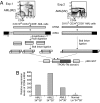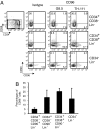CD96 is a leukemic stem cell-specific marker in human acute myeloid leukemia
- PMID: 17576927
- PMCID: PMC1904175
- DOI: 10.1073/pnas.0704271104
CD96 is a leukemic stem cell-specific marker in human acute myeloid leukemia
Abstract
Permanent cure of acute myeloid leukemia (AML) by chemotherapy alone remains elusive for most patients because of the inability to effectively eradicate leukemic stem cells (LSCs), the self-renewing component of the leukemia. To develop therapies that effectively target LSC, one potential strategy is to identify cell surface markers that can distinguish LSC from normal hematopoietic stem cells (HSCs). In this study, we employ a signal sequence trap strategy to isolate cell surface molecules expressed on human AML-LSC and find that CD96, which is a member of the Ig gene superfamily, is a promising candidate as an LSC-specific antigen. FACS analysis demonstrates that CD96 is expressed on the majority of CD34(+)CD38(-) AML cells in many cases (74.0 +/- 25.3% in 19 of 29 cases), whereas only a few (4.9 +/- 1.6%) cells in the normal HSC-enriched population (Lin(-)CD34(+)CD38(-)CD90(+)) expressed CD96 weakly. To examine whether CD96(+) AML cells are enriched for LSC activity, we separated AML cells into CD96(+) and CD96(-) fractions and transplanted them into irradiated newborn Rag2(-/-) gamma(c)(-/-) mice. In four of five samples, only CD96(+) cells showed significant levels of engraftment in bone marrow of the recipient mice. These results demonstrate that CD96 is a cell surface marker present on many AML-LSC and may serve as an LSC-specific therapeutic target.
Conflict of interest statement
Conflict of interest statement: I.L.W. was a member of the scientific advisory board of Amgen and owns significant Amgen stock. I.L.W. is also a cofounder and director of Stem Cells, Inc., and cofounded Cellerant, Inc. N.H. and I.L.W. have applied for a U.S. patent entitled “Identification of Cell Surface Marker for Acute Myeloid Leukemia Stem Cells” through the Stanford University Office of Technology and Licensing.
Figures




References
Publication types
MeSH terms
Substances
Grants and funding
LinkOut - more resources
Full Text Sources
Other Literature Sources
Molecular Biology Databases
Research Materials

